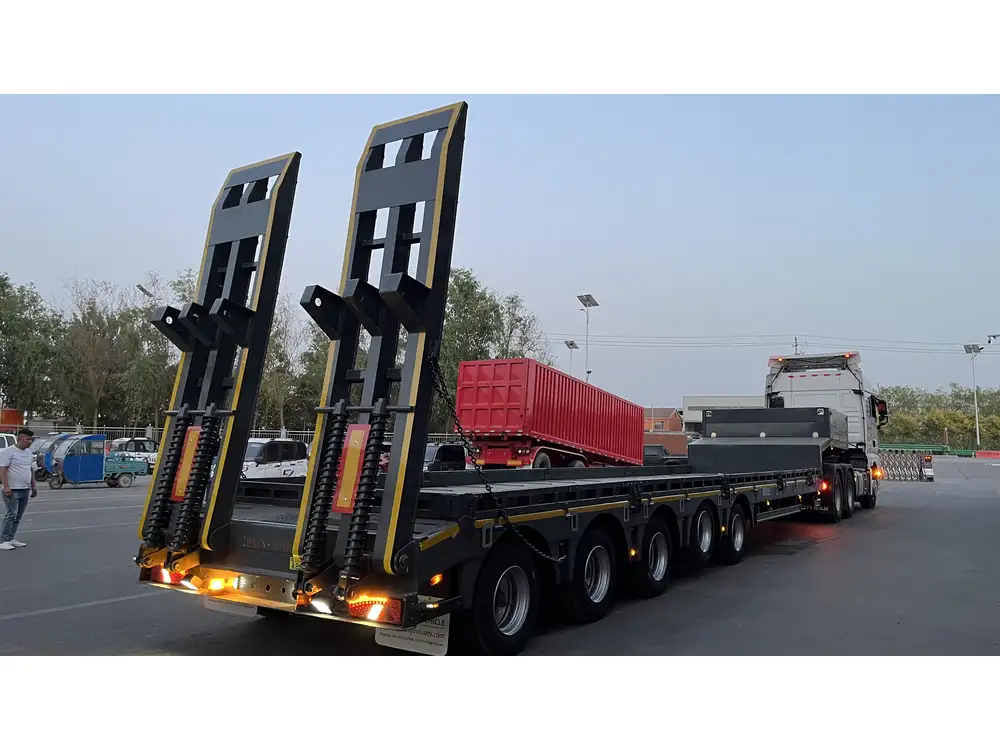In the world of logistics and transportation, semi-trailer axles play a crucial role. Understanding the weight of semi-trailer axles not only aids manufacturers, drivers, and fleet managers in compliance and efficiency but also optimizes the functionality of the entire transportation system. This article provides an in-depth look at how much a semi-trailer axle weighs, factors that influence this weight, and its implications on usage, safety, and legal regulations.
What is the Average Weight of a Semi-Trailer Axle?
A semi-trailer typically consists of multiple axles, with the most common configurations being single, tandem, and triple axles.
| Axle Type | Average Weight | Usage |
|---|---|---|
| Single Axle | 1,500 – 4,000 lbs (680 – 1,814 kg) | Smaller trailers, light loads |
| Tandem Axle | 4,000 – 13,000 lbs (1,814 – 5,897 kg) | Standard configurations |
| Triple Axle | 9,000 – 20,000 lbs (4,082 – 9,072 kg) | Heavy haul trailers |
When calculating the weight of the axles, it’s crucial to consider the combined weight of the axle and the load it carries. The total weight distribution across the axles plays a pivotal role in compliance with road regulations and vehicle performance.
Contributing Factors to Axle Weight
Axle Design and Material: The construction material (steel vs. aluminum) significantly influences the weight. Aluminum axles are lighter but may not provide the same strength as steel.
Axle Configuration: A single axle is considerably lighter than a tandem or triple axle setup. Understanding the purpose of your load will help determine the number of axles you need.
Payload Capacity: Different semi-trailers are designed to carry varying payloads – lighter trailers will utilize lighter axles and vice versa.
Accessories and Features: Additional components like brakes, hub assemblies, and other equipment will also affect the overall weight of the axle.
Legal Regulations: Compliance with the maximum allowable weight limits on public roads can also affect the number of axles and their specific designs.

Regulations Impacting Axle Weight
Notably, federal and state regulations impose limits on the maximum weight allowed on each axle. For example, the Federal Bridge Formula governs axle weight limits, ensuring that no single axle exceeds 20,000 lbs (9,072 kg) in the U.S.
Quick Reference for Weight Limits
| Axle Configuration | Maximum Weight Limit (lbs) | Maximum Weight Limit (kg) |
|---|---|---|
| Single Axle | 20,000 | 9,072 |
| Tandem Axle | 34,000 | 15,422 |
| Triple Axle | 42,000 | 19,050 |
Knowing these regulations is vital for fleet managers who need to avoid costly fines and ensure safety on the highways.
Implications of Axle Weight
Understanding axle weight has significant implications for transportation efficiency, safety, and legal compliance. Here are a few critical aspects to consider:

1. Load Distribution
Proper distribution of load across the axles ensures enhanced handling and stability during transport. Uneven weight distribution can lead to tire blowouts, decreased braking efficiency, and increased wear on individual axles.
2. Strategic Fleet Management
Incorporating the knowledge of axle weight into fleet management leads to better decision-making regarding loading, trailer selection, and maintenance schedules.
- Cost Efficiency: Minimizing unnecessary weight allows for greater payloads, improving profitability.
- Safety Protocols: Ensuring axle weight compliance fosters safer transport conditions for drivers and other road users.
3. Environmental Considerations
An overweight trailer can lead to increased fuel consumption due to higher engine loads, which subsequently elevates carbon emissions. Adhering to axle weight regulations contributes to sustainability goals within the logistics industry.

Choosing the Right Axle for Your Semi-Trailer
When selecting an axle for your semi-trailer, it is paramount to evaluate the specific needs of your transportation tasks. Here are key considerations:
1. Purpose of Use
- Local vs. Long-Distance: Local haul operations may benefit from lighter axles, while interstate operations that involve heavier loads will require more robust options.
2. Terrain and Road Conditions
- Rural vs. Urban: Axles designed for rural routes must withstand rougher terrain, potentially necessitating increased strength and durability.

3. Maintenance Requirements
- Long-Lived vs. Standard: Opting for high-quality materials might lead to higher initial costs, but can lower long-term maintenance.
Maintaining Your Semi-Trailer Axles: Best Practices
Well-maintained axles are vital for ensuring safety and performance. Here are essential maintenance tips:
| Maintenance Task | Frequency | Importance |
|---|---|---|
| Visual Inspection | After every trip | Identifies visible issues quickly |
| Lubrication | Monthly or as needed | Ensures smooth operation |
| Brake Inspection | Every 10,000 miles or annually | Prevents brake failure |
| Alignment Check | Every 6 months or as needed | Improves tire wear and handling |
Emerging Technologies in Semi-Trailer Axles
The transportation industry is consistently evolving, and several innovations can minimize weights while maximizing load capabilities.

1. Advanced Materials
Research into composite materials offers the potential for lighter and more durable axles. These innovations can lead to improved fuel efficiency and lower operational costs.
2. Smart Technology
Integration of sensors and monitoring systems can provide real-time data regarding axle conditions and performance, leading to proactive maintenance and improved safety standards.
Conclusion: Why Understanding Axle Weight Matters
The weight of semi-trailer axles is a cornerstone concept in the transportation industry, influencing every aspect of logistics—from safety and regulatory compliance to operational efficiency and environmental considerations.
By conducting thorough research and analysis, manufacturers, fleet managers, and drivers can make informed decisions about axle selection, maintenance, and loading protocols. Additionally, understanding the implications of axle weight can generate significant cost savings and enhance safety on our roads.
As the industry evolves with the integration of new technologies and materials, continuous education regarding axle weight will empower professionals to make strategic choices that lead to success in the competitive world of logistics.
Embracing these details, we can ensure not only compliance with safety regulations but also leverage operational efficiencies that propel our businesses into the future.



